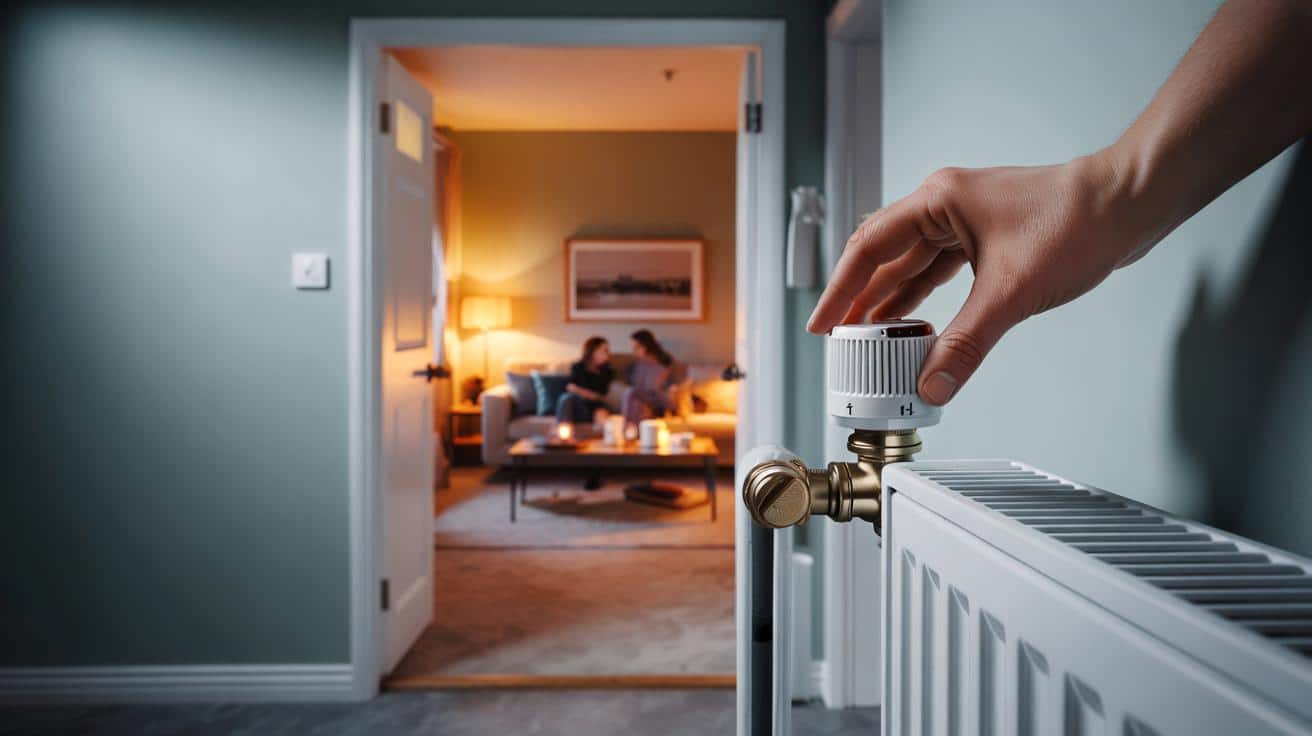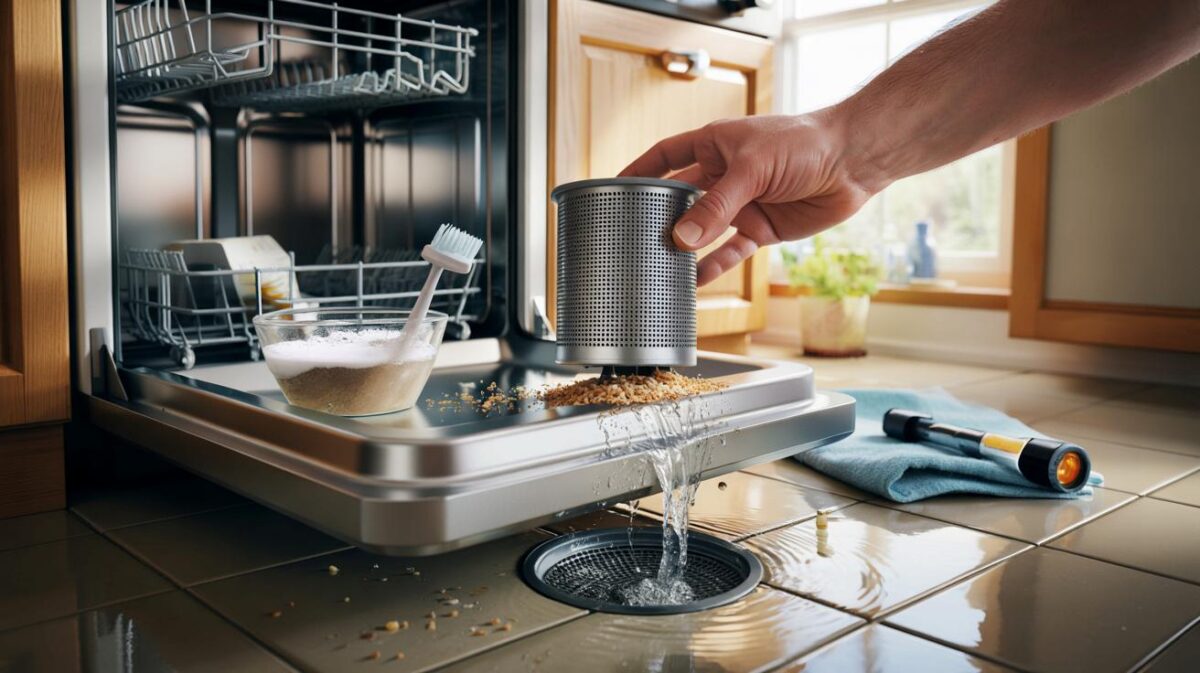A lounge that’s toasty at 23°C while the box room bakes for no one. Most homes leak money this way, not through bad boilers, but through misunderstood radiator thermostats — those little numbered caps called TRVs. Used well, they’re quiet geniuses. Used badly, they pour heat into empty air.
It’s a Tuesday evening and I’m standing in a narrow hallway in a North London terrace. The hall is strangely tropical, scarf off, gloves stuffed in a pocket, while the spare bedroom door is open to a faintly warm nothing. In the lounge, voices and mugs, steam lifting from tea. Every radiator has a plastic cap with numbers, all set differently, most at 4 or 5. “We just turn them up when we’re cold,” says Jess, shrugging, “and forget.” I crouch to the hall rad — behind a curtain, blasting away like a tiny sun. The fix is inches from my hand. A tiny spin. One click.
How TRVs really work — and why yours aren’t “just little taps”
A TRV isn’t a tap. It’s a local thermostat that throttles water flow to keep the room near a target temperature. Those numbers aren’t power levels; they’re comfort points. Set 3 and the valve lets heat in until the air around the head feels about right, then gently closes. Set 5 and it aims higher, not faster. It’s a set-and-wait tool, not a boost button.
We’ve all had that moment when you twist to 5 hoping for instant warmth. The room warms at the same pace the system can deliver; you’ve only raised the ceiling. In British homes, the rough scale is this: the snowflake symbol is frost protection (around 5–7°C), 1 is cool, 2 is mild, 3 sits near 19–20°C, 4 creeps above that, 5 is warm-warm (mid‑20s). Not lab-accurate, but truthy enough for real life.
The trick most people miss: a TRV senses the air at its own head, not where you sit with a book. Thick curtains, radiator covers, furniture and draughts can fool it. If the head is buried, it thinks the room is hotter than it is and shuts early. If it hugs a cold window, it may call for heat forever. Give it clear air, and it behaves like a clever little butler. *A quiet valve can save a noisy bill.*
Stop heating empty rooms: room-by-room settings that actually stick
Start with a ten-minute house walk. Living room and kitchen-diner where you hang out? Aim for 3 to 3.5. Bedrooms you like cooler? Try 2. Bathroom needs a short blast for showers? 3 or 4, then nudge back. Box room you use once a week? 1 or the snowflake. Close the door in low-use rooms so you’re not pulling heat through from warm spaces. **Shut the door.** It’s the cheapest “smart” control you own.
Don’t spin unused rooms to zero. Leave them on frost or 1 to keep the bones of the house dry and safe. That small background warmth helps against condensation and mould, and it stops the rest of the system from overworking as heat rushes to a single path. Be kind to the hallway, too. It doesn’t need to be balmy; 1 or 2 keeps the boiler happy without wasting comfort where nobody lingers. **Don’t heat the hallway.** Let’s be honest: no one really does that every day.
Here’s the clearer way to think about it: heat where the people are, limit where they aren’t, and keep the door story consistent.
“Heat the space you live in, and protect the spaces you don’t. TRVs are not decorations — they’re steering wheels.”
- Walk the house once, set each TRV deliberately, and label the caps with a tiny dot for “usual”.
- Clear 10–15 cm around every TRV head; lose the radiator cover in winter if you can.
- Use frost or 1 for spare rooms; step up to 2 only when someone stays over.
- Match habits: higher in the lounge early evening, lower back at bedtime.
- Bleed radiators and check lockshields if one room lags; balance matters.
Why your bills drop when your habits change, not just the hardware
Heat flows from warm to cool. If your lounge is at 21°C and a spare room is wide open to 15°C, that empty space becomes a sink, tugging warmth across floors and through gaps you can’t see. Your TRVs can end that tug-of-war. Lower the setpoint in low-use rooms and shut the doors, and you shrink the gradient that keeps stealing comfort. You’ll feel warmer in the rooms that count, with less boiler time in the background.
There’s another small win hidden in the numbers. Each TRV step is roughly 2–3°C. Dropping a room from 4 to 3 isn’t a tiny tweak; it’s a reframe. Softer temperatures mean fewer overshoots, fewer hissing moments when the valve throttles hard, and a boiler that condenses more often. You don’t need a fortress of gadgets to make this work. You need five minutes with your hands and a decision about where warmth lives.
Smart heads can help if your life runs on schedules, but the physics is the same. A cheap manual TRV, set honestly, beats a pricey smart one set forgetfully. **Use the snowflake, not zero.** The frost mark guards pipes in cold snaps and keeps the system moving. If a room must be “off”, turn it down and keep its door shut. That combination is the real off-switch.
Dial smarter, feel the same
Imagine the winter version of your home where the warmth pools exactly where you sit, talk, sleep. The spare room is calm and cool, not icy. The hallway stops pretending to be a sauna. The boiler hums less, everyone wears one fewer jumper, and no one argues over the big room thermostat because the little caps did the quiet lifting.
You don’t need to be perfect at this. You need a rhythm. Pick a “normal” for each space, mark it, and only nudge for moments that matter — guests staying, a long bath, a home workout. Open a door to share heat for an hour, then return it to its boundary. Tell your home what you want, room by room. Someone you know is still blasting heat into a room nobody uses. They’re paying for a warm ghost.
| Point clé | Détail | Intérêt pour le lecteur |
|---|---|---|
| Set room-by-room targets | 3 for living spaces, 2 for bedrooms, 1 or snowflake for seldom-used rooms | Immediate comfort where it counts, lower run time elsewhere |
| Keep TRVs breathing | No curtains or covers over the valve head; give it clear air to sense properly | More accurate control and fewer hot–cold swings |
| Doors are part of the system | Close low-use rooms; open only when you want to share heat | Stops warmth drifting into empty spaces and trims bills without feeling colder |
FAQ :
- What number on a TRV equals which temperature?Numbers are indicative, not exact. As a rule of thumb: snowflake ≈ 5–7°C, 1 ≈ 12–15°C, 2 ≈ 16–18°C, 3 ≈ 19–20°C, 4 ≈ 21–23°C, 5 ≈ mid‑20s.
- Should I turn radiators off in unused rooms?Better to set them low (snowflake or 1) and keep the door shut. That protects against condensation and cold spots while avoiding “heat drain” from living areas.
- Do TRVs work with a main room thermostat?Yes. The room thermostat tells the boiler when to run; TRVs shape where heat goes. Together they prevent overheating and cut wasted cycles.
- Why is my radiator cold even with the TRV up?If the room is at or above the setpoint, the TRV will close and the radiator cools. If it’s still cold and the room isn’t warm, check for trapped air or a stuck pin.
- Are smart TRVs worth it?They’re handy for schedules and remote tweaks, especially in large homes. The biggest gain still comes from sensible setpoints and door discipline.








